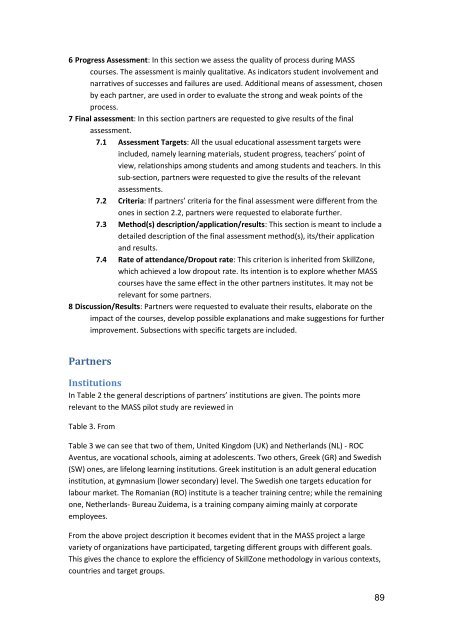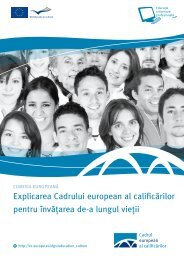Teaching and Assessing Soft Skills - MASS - Measuring and ...
Teaching and Assessing Soft Skills - MASS - Measuring and ...
Teaching and Assessing Soft Skills - MASS - Measuring and ...
Create successful ePaper yourself
Turn your PDF publications into a flip-book with our unique Google optimized e-Paper software.
6 Progress Assessment: In this section we assess the quality of process during <strong>MASS</strong><br />
courses. The assessment is mainly qualitative. As indicators student involvement <strong>and</strong><br />
narratives of successes <strong>and</strong> failures are used. Additional means of assessment, chosen<br />
by each partner, are used in order to evaluate the strong <strong>and</strong> weak points of the<br />
process.<br />
7 Final assessment: In this section partners are requested to give results of the final<br />
assessment.<br />
7.1 Assessment Targets: All the usual educational assessment targets were<br />
included, namely learning materials, student progress, teachers’ point of<br />
view, relationships among students <strong>and</strong> among students <strong>and</strong> teachers. In this<br />
sub-section, partners were requested to give the results of the relevant<br />
assessments.<br />
7.2 Criteria: If partners’ criteria for the final assessment were different from the<br />
ones in section 2.2, partners were requested to elaborate further.<br />
7.3 Method(s) description/application/results: This section is meant to include a<br />
detailed description of the final assessment method(s), its/their application<br />
<strong>and</strong> results.<br />
7.4 Rate of attendance/Dropout rate: This criterion is inherited from SkillZone,<br />
which achieved a low dropout rate. Its intention is to explore whether <strong>MASS</strong><br />
courses have the same effect in the other partners institutes. It may not be<br />
relevant for some partners.<br />
8 Discussion/Results: Partners were requested to evaluate their results, elaborate on the<br />
impact of the courses, develop possible explanations <strong>and</strong> make suggestions for further<br />
improvement. Subsections with specific targets are included.<br />
Partners<br />
Institutions<br />
In Table 2 the general descriptions of partners’ institutions are given. The points more<br />
relevant to the <strong>MASS</strong> pilot study are reviewed in<br />
Table 3. From<br />
Table 3 we can see that two of them, United Kingdom (UK) <strong>and</strong> Netherl<strong>and</strong>s (NL) - ROC<br />
Aventus, are vocational schools, aiming at adolescents. Two others, Greek (GR) <strong>and</strong> Swedish<br />
(SW) ones, are lifelong learning institutions. Greek institution is an adult general education<br />
institution, at gymnasium (lower secondary) level. The Swedish one targets education for<br />
labour market. The Romanian (RO) institute is a teacher training centre; while the remaining<br />
one, Netherl<strong>and</strong>s- Bureau Zuidema, is a training company aiming mainly at corporate<br />
employees.<br />
From the above project description it becomes evident that in the <strong>MASS</strong> project a large<br />
variety of organizations have participated, targeting different groups with different goals.<br />
This gives the chance to explore the efficiency of SkillZone methodology in various contexts,<br />
countries <strong>and</strong> target groups.<br />
89





